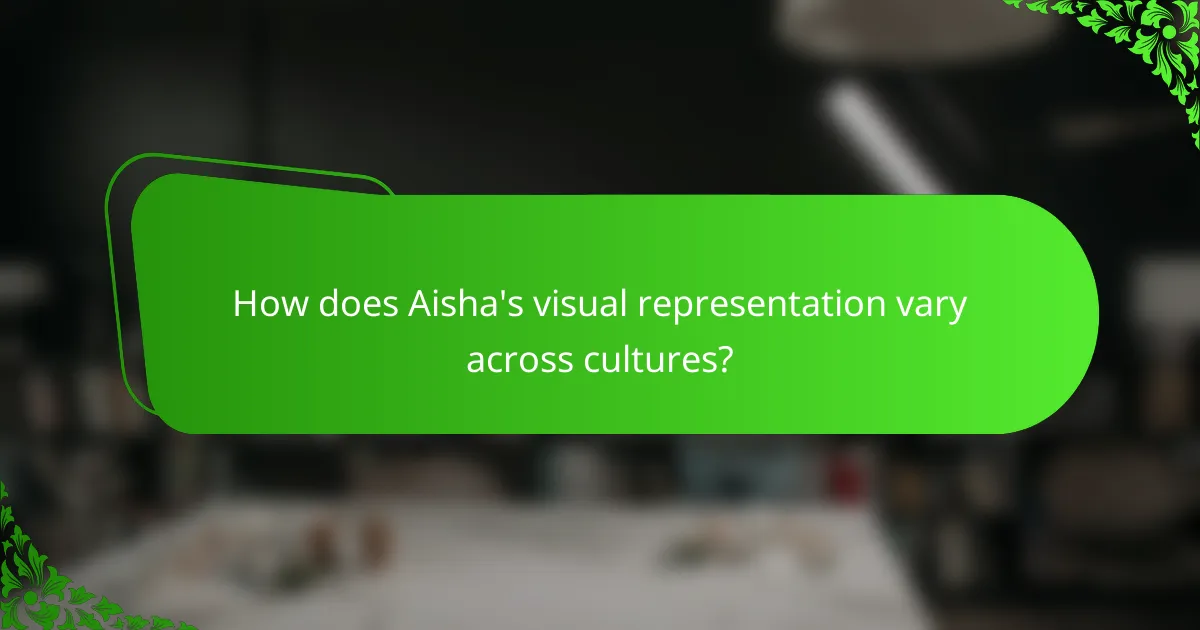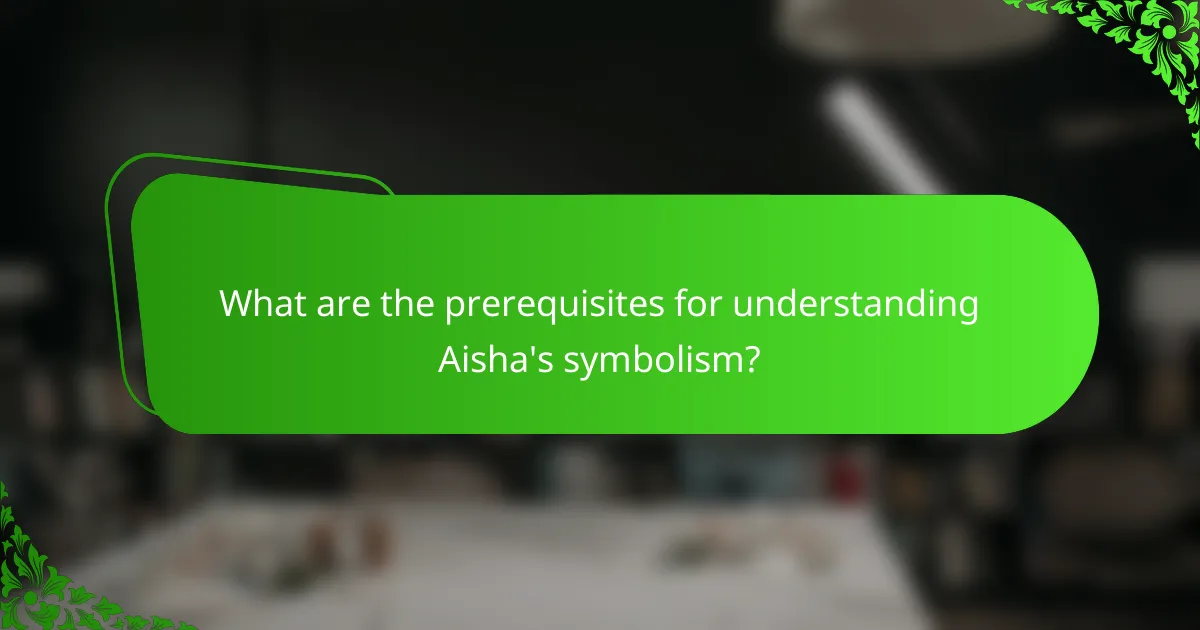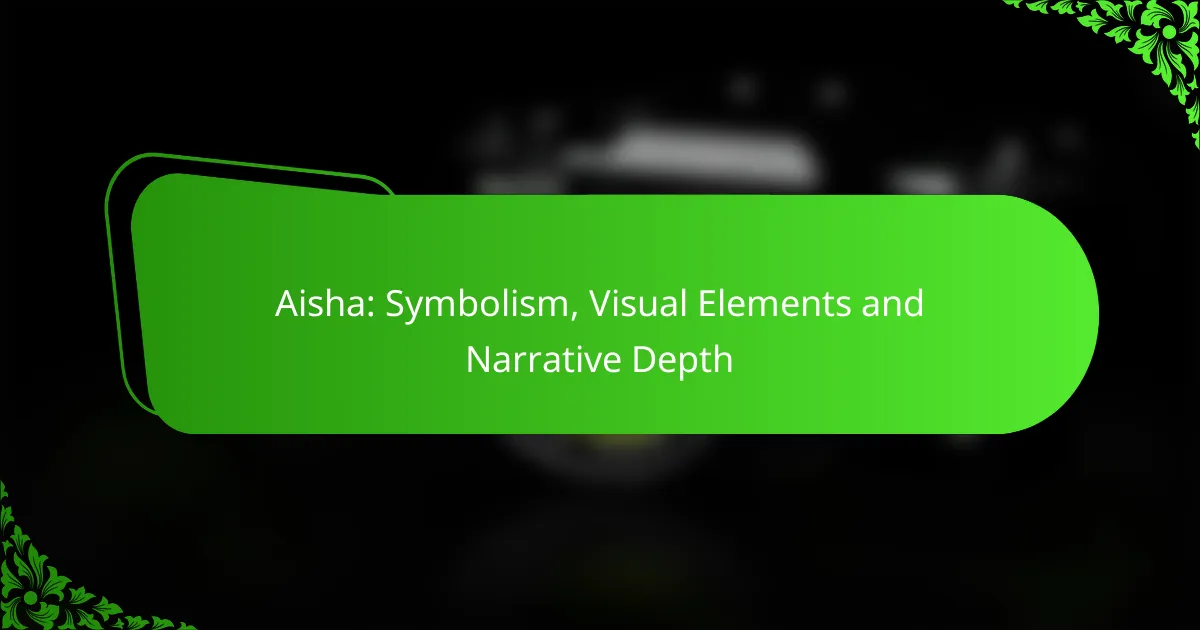Aisha is a compelling figure in literature, symbolizing strength, loyalty, and cultural identity. Her character not only embodies resilience and devotion but also reflects the intricate tapestry of her cultural background and personal experiences. The visual representation of Aisha varies across cultures, highlighting local values and artistic traditions, while her multifaceted traits contribute significant narrative depth, enriching storytelling and influencing plot development.

What is the symbolism of Aisha in literature?
Aisha often symbolizes strength, loyalty, and cultural identity in literature. Her character serves as a powerful representation of resilience and devotion, reflecting the complexities of her cultural background and personal experiences.
Representation of strength
Aisha embodies strength through her ability to navigate challenging circumstances while maintaining her integrity. Her character often faces societal pressures and personal struggles, yet she emerges resilient, showcasing the inner fortitude that many readers find inspiring.
In various narratives, Aisha’s strength is illustrated through her actions and decisions, which often challenge traditional norms. This portrayal encourages readers to recognize the strength within themselves and others, especially in the face of adversity.
Embodiment of loyalty
Aisha’s loyalty is a central theme in her character arc, often depicted through her unwavering support for family and friends. This loyalty not only highlights her personal values but also reflects broader themes of community and solidarity within her cultural context.
Literary examples frequently showcase Aisha’s sacrifices for those she loves, emphasizing the importance of loyalty in relationships. Readers can relate to her commitment, which serves as a reminder of the bonds that define human connections.
Symbol of cultural identity
Aisha represents cultural identity by embodying the traditions, values, and struggles of her community. Her character often navigates the complexities of cultural expectations while seeking her own path, making her a relatable figure for many readers.
Through Aisha’s experiences, literature explores themes of belonging and self-discovery, illustrating how cultural identity shapes individual narratives. This connection encourages readers to reflect on their own identities and the influences that shape them.

How does Aisha’s visual representation vary across cultures?
Aisha’s visual representation differs significantly across cultures, reflecting local values, beliefs, and artistic traditions. In some cultures, she is depicted as a symbol of strength and wisdom, while in others, her portrayal emphasizes beauty and femininity.
Artistic depictions in Middle Eastern culture
In Middle Eastern art, Aisha is often represented in a manner that highlights her historical and religious significance. Traditional paintings and calligraphy may depict her in scenes from Islamic history, emphasizing her role as a prominent figure in early Islamic society.
Common visual elements include intricate patterns and vibrant colors, which are characteristic of Islamic art. These representations often focus on her intelligence and leadership, showcasing her as a model for women in the community.
Modern interpretations in Western art
In Western art, Aisha’s representation has evolved to reflect contemporary values and perspectives. Artists may portray her in a more diverse range of roles, often emphasizing empowerment and independence, aligning with modern feminist ideals.
Visual elements in these interpretations can include abstract styles or mixed media, allowing for a broader exploration of her character. This shift often aims to challenge traditional narratives and highlight her multifaceted identity in a global context.

What narrative depth does Aisha bring to storytelling?
Aisha adds significant narrative depth to storytelling through her multifaceted character traits and the emotional resonance she evokes. Her complexity allows for rich character arcs and influences the overall direction of the plot, making her a pivotal figure in many narratives.
Complex character development
Aisha’s character development often showcases a blend of strengths and vulnerabilities, making her relatable and engaging. Her journey typically involves overcoming personal challenges, which can resonate deeply with audiences. For instance, she may struggle with identity or societal expectations, leading to growth that reflects broader themes of resilience and self-discovery.
As Aisha evolves, her relationships with other characters also deepen, revealing layers of her personality. This interplay can highlight contrasting values or beliefs, enriching the narrative and prompting readers to reflect on their own experiences. Writers should focus on creating realistic challenges for Aisha that facilitate her growth while maintaining audience empathy.
Influence on plot progression
Aisha often serves as a catalyst for key events in the storyline, driving the plot forward through her decisions and actions. Her motivations can create tension and conflict, propelling the narrative in unexpected directions. For example, her quest for justice might lead her to confront powerful adversaries, altering the course of the story significantly.
Moreover, Aisha’s choices can impact other characters, shaping their development and the overall dynamics of the plot. Writers should consider how her journey intertwines with others, ensuring that her influence feels organic and integral to the story. This interconnectedness not only enhances the plot but also enriches the thematic depth of the narrative.

What are the key visual elements associated with Aisha?
The key visual elements associated with Aisha often include specific colors, motifs, and symbols that convey her character’s depth and significance. These elements work together to enhance the narrative and emotional impact of her portrayal.
Color symbolism in her portrayal
Color plays a crucial role in the visual representation of Aisha, with specific hues often symbolizing her traits and experiences. For instance, shades of blue may represent her wisdom and calmness, while vibrant reds can signify passion and strength. Understanding these color choices can deepen the viewer’s connection to her character.
When analyzing Aisha’s portrayal, consider how the use of color shifts throughout her journey. Darker tones may indicate struggle or conflict, while lighter shades can suggest hope and resilience. This dynamic use of color helps to narrate her emotional evolution.
Common motifs and symbols
Common motifs associated with Aisha include elements like flowers, birds, and geometric patterns, each carrying distinct meanings. Flowers often symbolize beauty and fragility, while birds can represent freedom and aspiration. These motifs not only enhance her visual appeal but also enrich the narrative by reflecting her inner desires and challenges.
Additionally, geometric patterns may signify order and structure in her life, contrasting with the chaos she faces. Recognizing these symbols can provide insight into her character development and the themes explored in her story. Pay attention to how these motifs recur in different contexts to understand their significance fully.

How does Aisha’s character reflect societal values?
Aisha’s character embodies the societal values of her community, illustrating the expectations and roles assigned to individuals based on gender and cultural background. Through her experiences and choices, the narrative reveals how these values shape personal identity and social interactions.
Representation of gender roles
Aisha’s character serves as a lens through which traditional gender roles are examined. She often navigates the expectations placed upon her as a woman, highlighting the limitations and pressures that come with these roles. For instance, her struggles to assert independence while adhering to societal norms reflect a common tension faced by many women in similar contexts.
In many cultures, women are expected to prioritize family and domestic responsibilities over personal ambitions. Aisha’s journey illustrates this conflict, showcasing her desire for self-fulfillment while grappling with the societal expectations that dictate her behavior.
Reflection of cultural norms
Aisha’s character also mirrors the cultural norms prevalent in her society, emphasizing values such as honor, tradition, and community. Her actions often align with these norms, reinforcing the collective identity of her community. For example, her participation in cultural rituals underscores the importance of heritage and belonging.
Moreover, Aisha’s interactions with other characters reveal the complexities of navigating cultural expectations. The pressure to conform can lead to internal conflict, as seen in her relationships with family and peers, where loyalty to tradition often clashes with personal desires for change and progress.

What are the prerequisites for understanding Aisha’s symbolism?
To grasp Aisha’s symbolism, one must have a solid understanding of the cultural context in which she exists, as well as familiarity with the literary themes that permeate her narrative. These elements provide the necessary framework to interpret her significance and the deeper meanings behind her character.
Familiarity with cultural context
Understanding the cultural context surrounding Aisha is crucial for interpreting her symbolism. This includes knowledge of the historical, social, and religious influences that shape her character and actions. For instance, Aisha’s role in Islamic history and her relationship with the Prophet Muhammad are pivotal in understanding her representation in various narratives.
Additionally, recognizing the cultural norms and values of the time can illuminate why certain actions or traits are emphasized. Readers should consider how gender roles, societal expectations, and religious beliefs impact Aisha’s portrayal and the symbolism attributed to her character.
Knowledge of literary themes
A comprehensive understanding of the literary themes present in Aisha’s story enhances the interpretation of her symbolism. Themes such as power, agency, and faith are often interwoven in her narrative, reflecting broader societal issues. Recognizing these themes allows readers to see how Aisha embodies or challenges them.
Moreover, familiarizing oneself with motifs like loyalty, sacrifice, and the quest for knowledge can provide deeper insights into her character. Analyzing how these themes interact with Aisha’s actions and decisions can reveal layers of meaning that contribute to her symbolic significance in literature and culture.

What are the emerging trends in Aisha’s representation?
Emerging trends in Aisha’s representation highlight a shift towards more nuanced and diverse portrayals in various media. These adaptations often emphasize her complexity, cultural background, and the challenges she faces, moving away from traditional stereotypes.
Contemporary adaptations in media
Contemporary adaptations of Aisha in media encompass a range of formats, including film, literature, and digital storytelling. These adaptations often aim to reflect modern societal issues, such as gender equality and cultural identity, making her character more relatable to today’s audiences.
For instance, recent films and television series have portrayed Aisha as a strong, independent figure who navigates personal and societal challenges. This contrasts with earlier representations that may have depicted her in a more passive role. Such adaptations often include diverse casting and storytelling techniques that resonate with a global audience.
When engaging with these adaptations, it’s essential to consider the cultural context and the intended message. Viewers should be aware of how these portrayals can influence perceptions of gender and identity, fostering discussions about representation in media.










